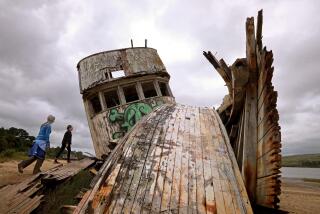Ship That Won’t Sink Puts Navy in Ecological Dilemma
- Share via
All that remains of the old USS Tortuga is a 400-ton chunk of wreckage rising from the shallow waters off San Miguel Island, and that is just about all the Navy needs.
Most of the Tortuga--a cruiser that spent its waning days as a target for missiles from the Pacific Missile Test Center at Point Mugu--was hauled out and sunk 20 miles offshore in August, eight months after it ran aground on San Miguel during a storm.
But a nettlesome 50-foot section of the ship’s stern remains firmly planted a few yards from shore, a symbol of frustration for Navy officials who anticipate environmental problems either from taking it away or from letting it stay.
Their task is complicated by the location of the brown ruin amid a spectacular array of marine life in the protected waters of the Channel Islands National Marine Sanctuary, just off a point that is a pupping grounds for colonies of harbor and elephant seals.
“We’re worried about the environmental problems of dragging it out,” said Ronald J. Dow, an ecologist who directs the Pacific Missile Test Center’s Environmental Division.
“There would be damage to bottom life just from hauling it. And we’d have to blast a channel to get a barge to it, because the underwater rock pinnacles could hold it up.”
On the other hand, letting it rest in peace would create a permanent 10-foot-tall eyesore off the pristine island, which is owned by the Navy but managed by the National Park Service as part of the Channel Islands National Park. And rust produced as the jagged metal ages could harm the underwater communities in the kelp forest nearby, Dow said.
Doing nothing also would anger the Park Service and environmentalists.
“The alternative we prefer is complete removal,” said Don Morris, the park’s acting chief of resource management. “We’re far better off now than when we had the entire hulk disintegrating there, and we’ll be glad to see this go too.”
Lt. Cmdr. Francesca M. Cava, manager of the Channel Islands National Marine Sanctuary, agreed.
“It’s a hazard for divers and boaters and an environmental hazard as well,” said Cava, an officer with the National Oceanic and Atmospheric Administration, which operates the 1,252-square-mile sanctuary. “As sea mammals haul out onto the beach to pup, they could get cut. We’ve already had one sea lion impaled on it.”
The Navy’s likely options could cost as much as $750,000, require the approval of NOAA, the Environmental Protection Agency and at least three other regulatory groups, and still imperil man and aquatic life.
Torch-wielding divers could cut the wreck into sections to be lifted out by helicopter, but surging waters would make their job difficult if not deadly, Dow said.
One sharp blast could yield a pile of manageable debris, but would also kill sea life. Lesser blasts could jar it so it could be pushed over and submerged, but low tides would expose it again, he said.
The Navy’s proposal, which is expected within two months, will mark the beginning of the Tortuga’s prolonged end.
The Tortuga, a 475-foot cruiser designed for the repair of submarines and other vessels at sea, was launched in 1945. It steamed through combat in Korea, landing the first group of Marines at Inchon, and was an active member of the fleet until it was mothballed in the early 1970s.
In 1983 it was outfitted for use as a target and moored at Port Hueneme. For the next four years it endured repeated hits by Tomahawk missiles. It was being prepared at sea for the final blow--the one designed to sink it--when a storm came up on Dec. 15, 1987.
The Tortuga broke loose from two accompanying tugboats, and in 12 hours was driven 24 miles from the waters of the Pacific Missile Test Range to San Miguel. The crash on the rocky beach broke off the stern segment, embedding it near the hulk.
It took eight months, 20 Navy divers from San Diego and Pearl Harbor and a professional salvage team from Seattle to complete the $1.6-million job of removing the hulk. Thousands of tons of metal were cut from it and barged to Long Beach for sale as scrap. The ship’s remains were refloated with air pumped into its ballast tanks and, finally, towed out to sea and scuttled Aug. 20.
“The hulk was a nice working platform, and you could float it on a bubble,” Dow said. “But that’s not the case with the stern.”
In fact, the elaborate engineering procedures required to refloat the Tortuga’s hulk may seem simple next to the contortions required to extricate its final chunk.
“This last part seems just as difficult, if not more so,” Cava said. “They just can’t reach it.”
More to Read
Sign up for Essential California
The most important California stories and recommendations in your inbox every morning.
You may occasionally receive promotional content from the Los Angeles Times.











